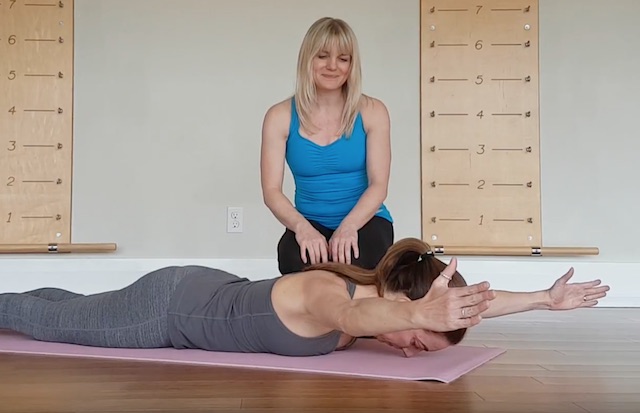
The most common misconception about upper-body strength is that it’s all about the power in our arms and shoulders.
While these muscles do play a significant role, real upper-body power means a strong chest and upper back, not just arms.
So, how can we tell if we are actually strong (or weak, for that matter!) in our upper bodies?
Pay careful attention to where you feel most of the work the next time you hold plank pose, downward dog, or flow through chaturanga dandasana. Do you feel strained in the top of your shoulders and up into your neck? Do you feel the work happening in your arms or your upper torso?
If you do not feel work in your torso and instead feel it all in your arms and experience strain in your shoulders and neck, this is a signal that your upper body needs some serious strengthening.
Poor upper-body strength is due to poor control of the shoulder girdle (shoulder blades and collar bones) and the muscles that support it. When there isn’t enough strength or support in the torso, we may feel strain above in the neck and shoulders, or below in the lower back. The other thing that happens when we have poor control of the shoulder girdle is that we then rely too heavily on our arms. Over time, this can make them hypermobile and unstable. Common injuries to watch out for that signal weak upper-body power are rotator cuff issues, frozen shoulder, and neck strain.
With upper-body strength, we often focus primarily on the outer, showy muscles—pecs (chest), deltoids (shoulders), and lats (wing muscles in the back). These are important muscles, but we need to understand the mechanics of the upper body and its arthrokinematics (joint movement).
Paying as much attention to good movement as trying to make muscles strong is key.
To develop real upper-body strength, consider the relationship between your spine, shoulder girdle, and arms. All three components need to be addressed and conditioned for integrated, all-over strength in the upper body.
With the proper support, we should feel like there’s power in our torso and that we are not just pushing with our upper arms, but like we are being pulled away from the ground. We will feel our arms working, but it should feel like the power from our abdominal walls and back is helping too.
Here is a tried and tested workout recipe that will strengthen our obliques, lats, traps, and serratus, properly priming our arms and shoulders for a pain and injury-free yoga practice.
Rib Circles
Kneel on hands and knees with a slight downward dip in your lower back. Imagine a hula hoop around your ribs and begin press your ribs around in a circle as if tracing the inside of the hoop. Make the circling motion as big as you like as long as there is no strain and you feel supported around shoulders and hips.
Repeat this motion 8 to 10 times in a clockwise direction. Repeat in the counterclockwise direction.
This exercise can be done 3 to 5 times per week.
Quadruped shoulder blades glide
Kneel on your hands and knees with a slight downward dip in your lower back. Allow your head to hang down. Gradually press your shoulder blades together as your chest moves toward the floor slightly. Then, press your hands into the floor and separate or widen the space between your shoulder blades.
Do 8 to 10 reps. Rest in child’s pose. Repeat two more times for a total of three sets.
This exercise can be done 3 to 5 times per week.
Conducting Arms
Kneel tall and align knees, hips, and shoulders vertically. Reach arms out in front, holding them at or just below shoulder height. Imagine getting ready to conduct an orchestra with elbows bent and hands poised. Start to move arms toward and away from each other as if conducting. Keep elbows bent, and make movements deliberate and rhythmical.
Do 15 to 20 reps. Rest arms at sides for 15 seconds. Repeat two more times for a total of three sets.
This exercise can be done 3 to 5 times per week.
Prone W to V arms
Lie face down with arms bent at sides, hands near shoulders like the letter “W.” Turn palms to face each other. Gently pull your abdominal wall away from the ground so the muscles tighten. You may also feel your lower back lengthen slightly. Gently roll shoulders back and lift arms a few inches. Keep elbows slightly lower than shoulders and gradually reach arms into a “V” up by your ears. Hold for five seconds. Reverse the motion and return to the “W.” Hold for five seconds. Alternate back and forth and keep abdominals pulled away from the ground to support your lower back.
Do 4 to 6 cycles of “W” to “V.” Rest with arms on the ground for 10 seconds. Repeat two more times for a total of three sets.
This exercise can be done 3 to 5 times per week.
Plank to Pike
Start on forearms and knees. Reach one leg back and then the other to come into a plank position. Ensure elbows are under shoulders and try to create one long, continuous line from shoulders to hips to feet. Press elbows into the floor as you pike hips up and back. Reverse the motion and return to plank.
Do four cycles of plank to pike. Rest in child’s pose for 15 seconds. Repeat two more times for a total of three sets.
This exercise can be done 2-3 times per week.
Author: Margot McKinnon
Image: YouTube; Boemski/Flickr
Editor: Emily Bartran











Read 0 comments and reply